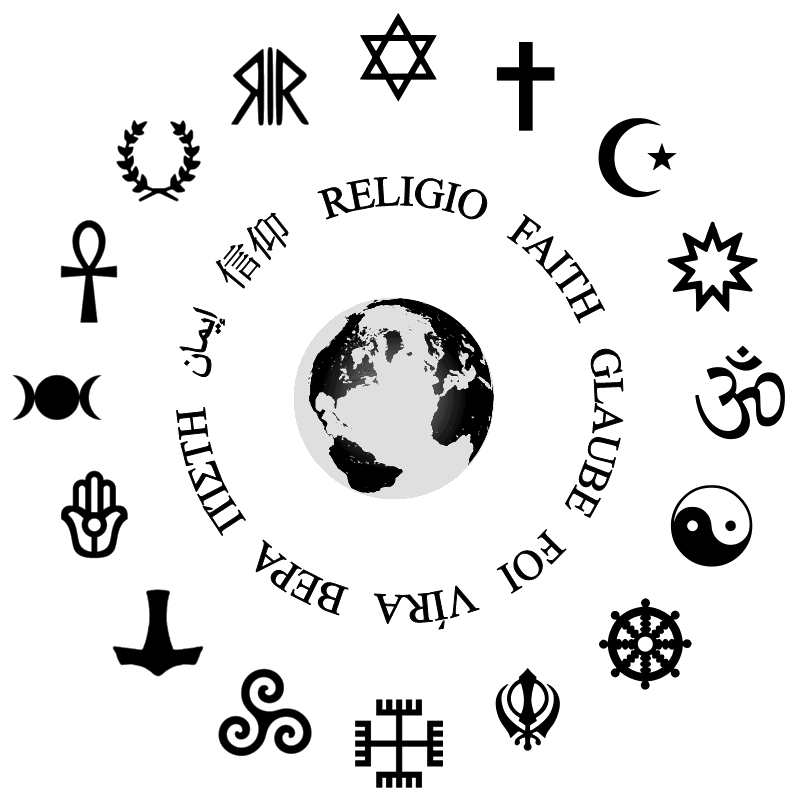Difference Between Faith and Religion
The concepts of faith and religion are strictly intertwined, although not always co-dependent. After centuries of debate, scholars have yet to reach a common understanding and definition of religion. Religion is a social and cultural system, which is based on rituals, practices and organizations. Although religion is a human construct, it is often built around a god or a deity that people worship. Faith and belief in a same deity is what brings people together, and what makes them improve and enlarge their communities. Yet, the concept of fait does not necessarily have to be linked to religion. The term “faith” implies loyalty, trust and fidelity. Although the two concepts may appear interchangeable, they are, in fact, deeply different.
What is Faith?
Faith is a peculiar feeling, which is often hard to express and identify. The idea of faith is linked to the concepts of trust and loyalty – and is, therefore, often associated to religion. In this context, faith is defined as total and complete belief in the deity and in its intermediaries (priests, pastors, etc.). In most religions, the deity is worshipped by communities that are brought together by the inexpressible and indefinable feeling of faith, trust and abandonment. Any individual who approaches a religion is bound to question his faith (often for its entire life), as deciding to abandon rationality and empiricism to dive into the uncertainty and mysteries of religion is an important step. Not everyone has the capacity (or the willingness) to question his sets of beliefs and principles to embrace a new truth (the deity). Most scholars define faith (in particular faith in a deity) as a personal, mysterious and individualistic feeling, that can hardly be put into words and that can hardly be rationalized.
What is Religion?
Although there is no common agreement on the meaning and main features of religion, the term often refers to a social and cultural system, created by a group of men who worship a common deity. Religions can be very different (i.e. monotheist, polytheist, animist, etc.) and can be characterized by very different rituals and procedures. Religious practices may include veneration, initiations, matrimonies, funerals, prayer, art, music, rituals, sermons, sacrifices, public services and many other aspects of a person’s life. Furthermore, religions have history, narratives, books, sacred places, ethical and moral standards and symbols. Man has always looked at deities, gods and supernatural forces to give a meaning and purpose to life, and to understand the idea of death (and of life after death). Some of the main (and most common) religions include:
- Christianism;
- Islamism;
- Buddhism;
- Shintoism;
- Taoism;
- Confucianism; and
- Hinduism.
Religion is a source of comfort for men and women, but it has also been (and continues to be) the origin of conflicts, wars and discrepancies between cultures and social groups.
Similarities between Faith and Religion
As faith and religion are strictly linked and can be co-dependent, we can identify few similarities between the two. Indeed, in this case we are considering faith in the sense of religious faith – individual belief in a deity (or god) that can be expressed through religion and its rituals and procedures. Some of the main similarities between faith and religion include:
- The two concepts can be co-dependent. In fact, some religions were (and are) created on the basis of beliefs and faith, while faith is the key element that brings communities together and that holds the entire religious structure;
- Faith and religion are tools that shape cultures and social structures (and vice versa). They are key elements that characterize specific cultural groups and that allow individuals to find their identity within larger groups; and
- Religion and faith are mutually reinforcing. A person’s growing faith can strengthen the religious structure and create a stronger bond within the group. At the same time, a compelling religious argument can lit the spark of faith in some individuals.
Difference between Faith and Religion
Faith and religion are similar, yet very different, concepts. Religions are historic and cultural systems that evolve with time, while faith is an individualistic, personal feeling of one person. Indeed, faith can be shared and others can start accepting and believing in certain things/deities/procedures, but, in general, faith is a much narrower concept if compared to religion. Some of the main differences between the two include:
- Faith can be a very irrational belief (or, at least, it may seem irrational to others) and can be very complicated to express and share with others. Religion is a means through which people can express their faith. For instance, Christians believe in Jesus, God and the Holy Spirit, and the mass and all other Christian rituals are a way to celebrate their faith and to strengthen their believes;
- Religion is a social construct that evolves with time and that can bring people together, but can also divide families and create discrepancies and clashes among societies. Conversely, faith has a much smaller impact on society, as it is an individualistic feeling that may never be expressed;
- Religion is based on rituals and procedures (i.e. ceremonies, prayers, initiations, public services, art, etc.) while faith is not linked to any of these concepts, but can be expressed in various different ways. Faith can be channeled through “official” and widely accepted procedures (i.e. mass, pilgrimages, etc.) or can be kept unspoken and unexpressed; and
- Religion is (or should be) based on faith, but faith is not always based on religion. Some people start going to church or to perform religious rituals because they are influenced by their social and cultural environment, and not because they are moved by faith and trust. Conversely, faith may lead some people towards religion, but can hardly be imposed or forced upon one person by social and cultural dogmas.
Faith vs Religion: Comparison Table
Building on the key differences outlined in the previous section, we can identify few other aspects that differentiate faith and religion.
Summary of Religion and Faith
The concepts of faith and religion are strictly linked to each other and to the idea of spirituality. While faith is a personal and individualistic feeling – associated to trust and belief – which may prove hard to express, religion provides the words express what is fundamentally inexpressible. Even though there are hundreds of different religions in the word, the idea of faith is universal, and individuals often use different religious traditions (or different languages) to express the same concepts. Religion is based on rituals, public services, art, music, history, buildings and sites, while faith is usually lived and expressed in a more private dimension. Religions are a social and cultural system, created by men who were (and still are) looking for the meaning of life and for answers to universal questions. Religion provides the answers, and faith is what makes people believe that those are the right answers.
- Difference Between Michelle Obama and Melania - January 29, 2019
- Difference Between Trump and Modi - December 4, 2018
- Difference Between Carbon Tax And Cap And Trade - December 4, 2018
Search DifferenceBetween.net :
Leave a Response
References :
[0]Stenger, Marry Ann. "Faith (and religion)." The Cambridge Companion to Paul Tillich (2009): 91.
[1]Oman, Doug. "Defining religion and spirituality." Handbook of the psychology of religion and spirituality 2 (2013): 23-47.
[2]Bellah, Robert Neelly. "Religious evolution." Readings in social evolution and development. 1970. 211-244.
[3]Image credit: https://pixabay.com/en/faith-wallpaper-wallpaper-of-faith-2593756/
[4]Image credit: https://en.wikipedia.org/wiki/Portal:Religion#/media/File:RELIGIONES.png



